Are you having trouble keeping up with rapid changes in the gaming industry in Japan? In 2022, Japan ranked as the third largest video game market globally, just behind China and the United States.
This post will help you get ahead of the curve by explaining 12 big trends shaping Japanese gaming through 2025—including mobile games, augmented reality (AR), esports events, and more.
Keep reading to find out what’s next for gamers in Japan.
Key Takeaways
Japan is shifting from home consoles to mobile gaming; by 2024, mobile game revenue will reach $16.77 billion, driven by gacha games (e.g., Pokémon Masters EX) and RPGs like Final Fantasy on smartphones.
Virtual reality (VR) and augmented reality (AR) are rapidly expanding in Japan; the VR gaming market reached $1.79 billion in 2024 and could hit around $4.38 billion by 2033 due to growth led by Sony PlayStation hardware.
Esports popularity is soaring in Japan with major events scheduled for 2025 such as EVO Japan, Tokyo eSports Festa, and inclusive festivals like PARA eSports featuring matches for Pokémon, Street Fighter II, Valorant, League of Legends, Tekken along with showcasing emerging VR tech.
Classic arcades continue losing popularity: arcade revenues dropped sharply to about $4.1 billion (470 billion yen) back in 2013 amid rising competition from smartphones, handheld systems like Nintendo Switch launched in 2017 selling over half a million units shortly after launch.
Live-service games offering regular updates have gained strong traction; subscription models including Xbox Game Pass and Nintendo Switch Online drove the Japanese gaming market toward a total value of approximately $26.3 billion during the year 2024 alone.
Table of Contents
History of the Gaming Industry in Japan
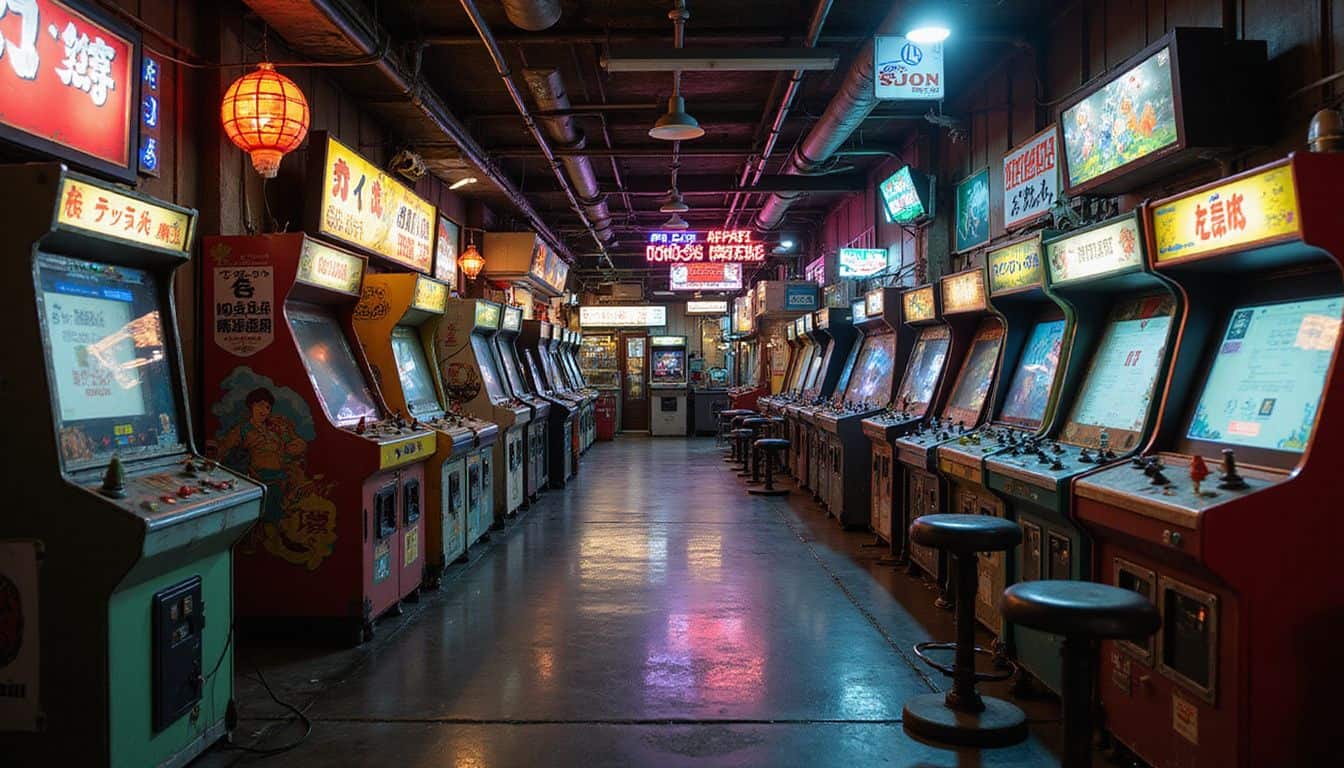
Japan gave the gaming world iconic hits like “Space Invaders” and Nintendo’s Famicom, reshaping video game culture globally. From arcade halls buzzing with excitement to consoles in millions of homes, Japan led a massive evolution of how we play.
Post-War Entertainment and Early Beginnings

After World War II, Japan enjoyed strong economic growth and looked for fresh new fun. Electro-mechanical games like TV Tennis Electrotennis opened doors to a whole new way of playing in the 1960s and early 1970s.
By 1978, Taito launched Space Invaders, the first Japanese video game with big global fame. Games soon grew from simple tasks such as shooting aliens or bouncing squares into complex arcade hits like Galaxian and Gun Fight.
This laid a strong base for today’s booming Japanese gaming industry.
The Arcade Era: From Pinball to Video Games
From the lively beginnings of early post-war entertainment, Japan soon embraced arcade games. This shift began in 1971 with Atari’s launch of “Computer Space,” marking a new kind of public play beyond pinball machines and light-gun games.
Arcades quickly rose as gaming hubs across Japan, driven largely by Taito’s groundbreaking game “Space Invaders” in 1978. Players spent endless hours mastering shoot ’em ups like this one, pushing these playable cabinets to immense popularity.
In arcades during the late 1980s and early 1990s, action-heavy titles found strong footing among fans. Capcom notably reshaped fighting games forever when it released “Street Fighter II” in 1991—a landmark hit that sold an incredible 53 million units worldwide by December 2023.
Games such as Sega’s racing classic “Hang-On,” created by Yu Suzuki on innovative arcade hardware, continued fueling excitement for fast-paced gaming experiences outside Japanese homes before home consoles took center stage.
The Rise of Home Consoles: From Famicon to PlayStation
The Japanese video game market exploded with home consoles after Epoch launched TV Tennis Electrotennis in 1975. Soon after, Nintendo took the spotlight in Japan and overseas with the Family Computer (Famicon) in 1983, known globally as the Nintendo Entertainment System (NES).
This powerful little box introduced classics like Super Mario Bros., Duck Hunt, and Dragon Quest, selling over 60 million units worldwide by the end of its run. Sega’s Mega Drive challenged it later on — creating intense rivalry between console giants.
Sony entered boldly into console gaming with PlayStation in 1994—the start of a fresh era for action-adventure games and JRPGs such as Final Fantasy VII. The arrival of discs instead of cartridges brought improved graphics and bigger adventures to gamers everywhere.
Sony soon became a leader against rivals Sega Saturn and later Nintendo’s fifth-generation N64 console. PlayStation notched huge sales worldwide that secured Japan’s spot at the top-tier stage within global video game industry dominance.
Modern Gaming Trends: Digital and Mobile Revolution
Home consoles like the PS4 and Wii U shaped gaming history, but now digital and mobile gaming lead Japan’s game industry. Mobile gaming alone is set to hit $16.77 billion in 2024, driven by popular gacha games and Japanese RPGs such as Pokémon and Final Fantasy.
Players spend around $150 each year on games, boosting Japan’s total market toward a huge $28 billion in 2024. Even PC games are growing fast—reaching $1.61 billion in Japan by 2023—a big jump from only 5% of that figure back in 2019.
Fans can also discover & compare top online casinos for entertainment beyond traditional video games.
Mobile devices are quickly becoming gamers’ go-to platforms, overtaking classic console choices.
Key Platforms in the Japanese Gaming Industry
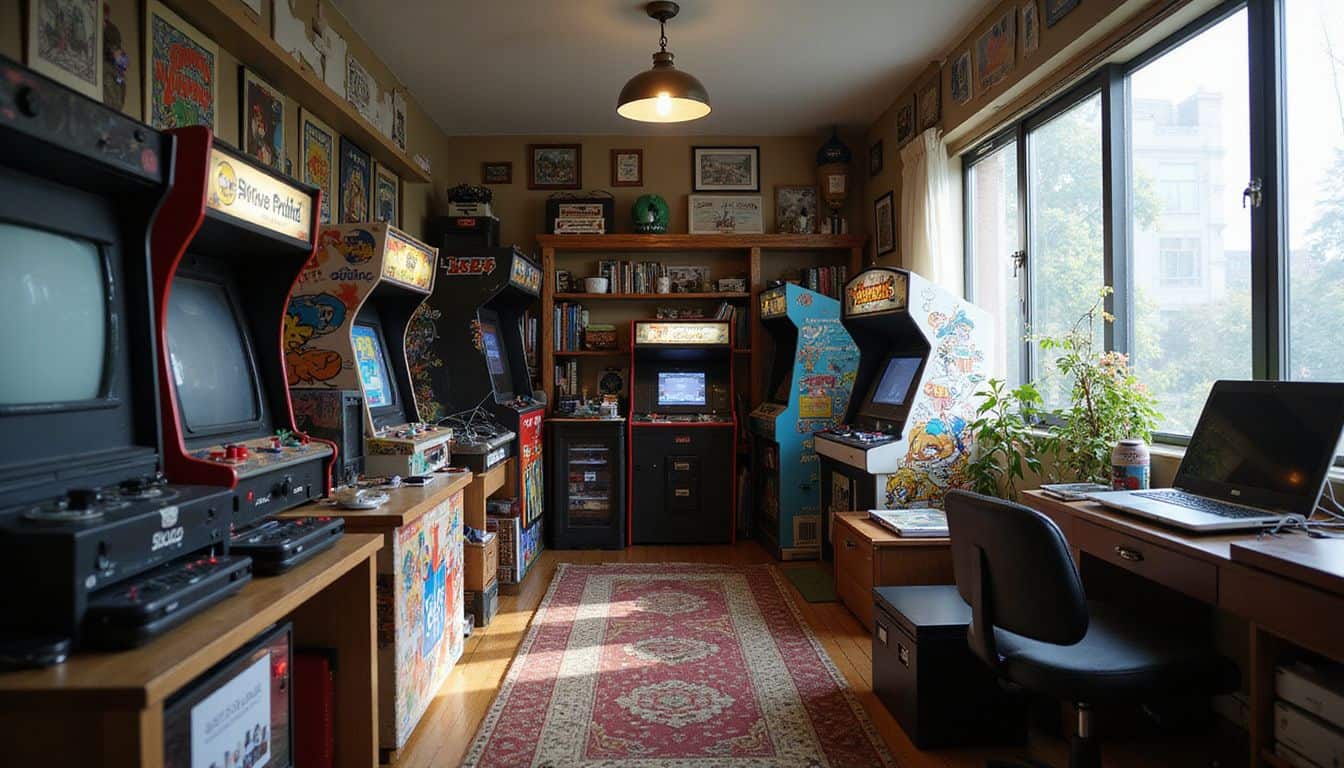
Japan’s gaming market thrives on platforms that range from nostalgic arcade cabinets to advanced home setups and pocket-sized devices—each shaping the way players engage; curious about which ones dominate play today?
Arcade Machines
Arcade machines exploded into popularity in Japan during the 1970s and 1980s. Games like Pac-Man, launched by Namco in 1980, pulled all kinds of players into arcades and set off a gaming craze.
Classic hits such as Space Invaders from Taito inspired waves of similar shooting games called “bullet hell” or danmaku shooters that challenged gamers’ reflexes. Sega led this scene for years, holding onto about 60% market share by 2007.
Yet arcade gaming has seen rough times lately due to shifting trends toward console gaming and mobile apps. By 2013, arcade revenue had dropped down sharply to around $4.1 billion (470 billion yen), a sign that home consoles and handheld devices have changed how many people prefer their playtime today.
While arcades still hold nostalgia with titles like Donkey Kong or The Tower of Druaga keeping retro spirit alive among hardcore fans, fewer casual gamers step inside these days than before.
Home Consoles
Home consoles transformed gaming in Japan, starting with Nintendo’s Family Computer/Nintendo Entertainment System, known as Famicom, in 1983. Early games like “Dragon Warrior,” “Final Fantasy,” and “Phantasy Star” made Japanese role-playing games popular across the globe.
Sony then jumped ahead with PlayStation leading into newer generations; on launch weekend alone in 2014, the PlayStation 4 sold an astonishing 322,083 units in Japan. Nintendo also stayed a strong player as shown by its success with Wii U and the Switch system—“Super Mario Party Jamboree” became Japan’s bestselling console game of 2024.
Despite competition from mobile platforms and virtual reality (VR) options emerging quickly today, these household systems still form a core part of Japan’s game market valued at around 377.4 billion yen in 2022.
Now handheld devices are becoming equally influential among Japanese players who seek portable entertainment everywhere they go.
Handheld Consoles
Unlike home consoles tethered to TVs, handhelds offer gaming on the go. Nintendo’s Game Boy changed portable play in 1989 and quickly became a hit across the globe. The Nintendo DS followed, gaining popularity because it was easy to carry anywhere.
Later came the Nintendo Switch, blending console power with portability—selling more than 500,000 units just one month after launching in Japan in 2017. Titles like Pokémon and action role-playing games such as Secret of Mana thrived on these handheld systems, bringing fresh fans into [Japanese culture](https://www.geekextreme.com/why-is-japanese-culture-so-popular/).
New devices keep appearing today as players seek out deeper stories and sharper graphics from their portable screens.
Handheld gaming is freedom—play anytime you want. – Satoru Iwata
Mobile Gaming
Handheld consoles still hold a special place, but mobile gaming has quickly risen in Japan. By 2024, revenue from mobile games here will hit around $16.77 billion. Popular types like gacha games and visual novels lead this surge, pulling in players with stories and collectible characters.
Gaming on smartphones opens access to big titles such as Pokémon or Final Fantasy right at your fingertips — no console needed.
In fact, user numbers for Japanese mobile gaming are expected to reach up to 31.1% by 2027. This growth matches a rising average revenue per user (ARPU), predicted at about $480 in 2024 alone.
Clearly the shift away from traditional platforms like arcade games and home consoles is real; today’s gamers prefer convenience over fixed setups like classic Space Invaders cabinets or Nintendo’s NES systems once offered decades ago.
Notable Game Genres in Japan

Japan’s gaming scene brings standout genres—from epic action RPG adventures like Final Fantasy to story-rich visual novels. Fans also get hooked on addictive gacha games, strategy RPGs, and classic turn-based battles found in series like Pokémon.
Action Games
Action games stand among the top genres preferred by Japanese players for 2024. Capcom’s Monster Hunter: World perfectly shows this trend, selling over 10 million units in 2018 alone.
Beating epic beasts or dodging fast attacks with a sharp battle system brings thrill and excitement to gamers.
From arcade games like Space Invaders to console hits on Nintendo Entertainment System (Famicom), action-packed play has shaped video games in Japan. Titles like Pokémon offer adventure, Final Fantasy blends action RPG styles, while modern mobile gaming continues these traditions—in fresh ways—with simple tap controls and quick battles:
There’s nothing quite as satisfying as mastering an intense boss fight—that adrenaline rush makes every minute worth it.
Japanese Role-Playing Games (JRPGs)
Japanese Role-Playing Games (JRPGs) feature clear, linear storytelling and turn-based combat. Dragon Quest started the JRPG trend in Japan back in 1986, and it quickly became popular on home consoles like Nintendo’s Famicom system (known globally as NES).
The genre is still strong today with huge hits such as Final Fantasy 7 Rebirth and Dragon Quest III HD-2D Remake released in 2024. These console RPGs offer engaging stories that geeks love — mixing fantasy worlds, complex characters, and detailed plots.
Game studios keep fans excited by giving fresh life to classic titles with new technology like HD remakes.
Alongside JRPGs, Gacha games have also made waves across Japan’s gaming scene recently.
Gacha Games
Gacha games have become a core part of gaming trends in Japan, showing strong signs of future growth. Genshin Impact, a popular gacha RPG and open-world adventure game, hit 2.37 million downloads in Japan alone during December 2023.
The gacha market is expected to keep growing at a rate of 13.8% from 2019 up to 2033, driven mainly by role-playing (RPGs) and card-style games. Players roll for rare heroes or upgrade items for small fees through chance-based pulls.
Notable franchises using the system include Pokémon Masters EX and Final Fantasy Brave Exvius—both blending engaging storylines with randomized draws that keep geeks hooked on improving their collections.
Visual Novels
Unlike Gacha Games, Visual Novels (VNs) offer a rich story as their main feature. This genre has grown fast over the past ten years, reaching a market value of $139 million in 2023 and should hit around $620 million by 2031 with an average annual growth rate of 8.5% from 2024 to 2031.
Fans love VNs like “Ace Attorney” and “Steins;Gate,” for their deep plots and player choices that affect how stories end. From first-hand experience at Tokyo Game Show, it’s clear Japanese studios continue to create top-notch visuals and gripping tales that pull gamers into hours of play on consoles, handheld devices like Nintendo’s Famicom or mobile gaming platforms.
These story-driven games combine artful graphics with engaging text dialogue, making them stand out among JRPGs such as Final Fantasy or Pokémon which rely more heavily on combat mechanics than plot alone.
Trends Shaping the Japanese Gaming Market
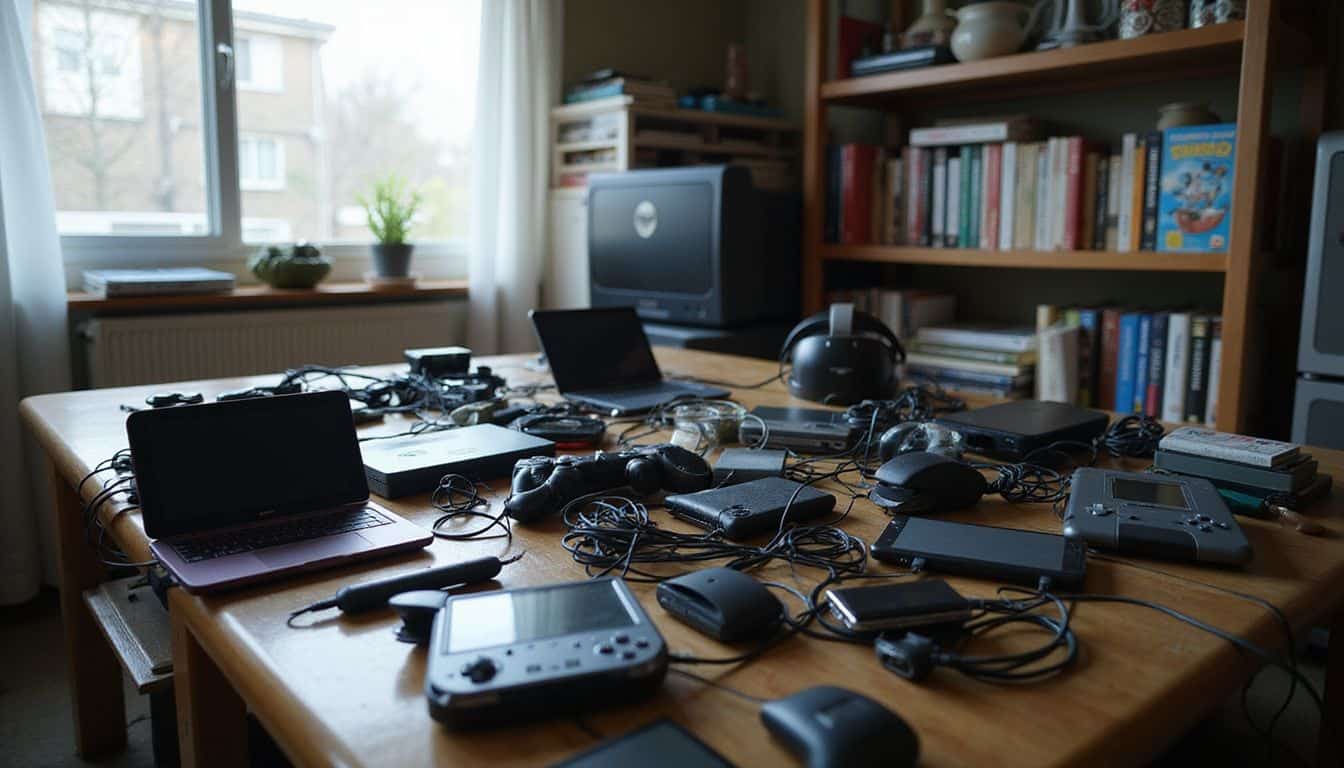
Japanese gamers are quickly adopting mobile devices and VR headsets—the future is already here. Handheld consoles and live service plans are also gaining popularity, changing how people play games across Japan.
Shift from Console to Mobile Gaming
Gamers in Japan are shifting from home consoles to mobile gaming at a rapid pace. Projections say the country’s mobile game revenue will hit $20.9 billion by 2025, boosted by popular gacha games and tactical RPGs that can be played anytime, anywhere.
Titles such as Pokémon have thrived on handheld devices like Game & Watch for decades; now they grow even bigger on smartphones with cross-platform features becoming central.
Smartphone gaming expands the audience by creating deeper play experiences using augmented reality (AR) and virtual reality (VR). Major Japanese game studios invest heavily in these new technologies to grab gamers’ attention outside traditional console setups like Famicom or eighth-generation systems, including Wii U and PlayStation 4.
Mobile screens pull players into familiar worlds—like Final Fantasy or Live A Live—but offer fresh ways to connect through live-service events or regular content updates.
Expansion of Virtual Reality (VR) and Augmented Reality (AR)
Virtual reality (VR) and augmented reality (AR) are growing fast in Japan’s gaming market. The VR gaming industry alone was valued at $1,789 million in 2024 and will reach around $4,382 million by 2033, with a growth rate of 10.5% per year from 2025 onwards.
Strong advances in VR hardware from companies like Sony PlayStation and Oculus lead this quick growth. Popular franchises like Pokémon and Final Fantasy also drive adoption by mixing anime themes into immersive experiences.
At the same time, AR brings another exciting wave to mobile gaming through games that blend real-world views with digital graphics — much as Pokémon Go did years before. As technology improves, gamers can expect AR visuals and gameplay to become even more detailed on smartphones or handheld consoles such as Nintendo Switch successors.
The increasing ease-of-use for these tools means wider access for geeks who want an engaging game experience beyond standard console gaming or traditional JRPGs.
Growth of Handheld Consoles
Handheld consoles remain a favorite for gaming geeks in Japan. Nintendo paved the way with portable hits like the Nintendo DS and Switch, both loved for their ease of use on trains or buses.
These gadgets let players enjoy Pokémon battles or Final Fantasy adventures anytime and anywhere. Japanese gamers value portability and comfort over bulky home consoles, leading handheld sales to thrive each year.
By 2024, console gaming in Japan hit $4.85 billion, boosted by strong handheld sales from brands like Nintendo.
The success of handheld devices is easy to see through titles that became staples such as tactical role-playing games and JRPGs designed specifically for smaller screens. Even now, games with gacha features continue booming popularity on these mobile-friendly systems among fans eager to build dream teams instantly through random draws.
This steady trend shows how deeply portable play shapes modern gaming trends in Japan today compared to traditional arcade or fixed-console setups at home.
Live Service Games and Subscription Models
As handheld consoles gain traction, live service games are also growing strong in Japan’s gaming market. Live games like Final Fantasy XIV keep players hooked with frequent updates, online events, and new content to explore—like special dungeons or seasonal rewards.
In 2024 alone, Japan’s game industry reached $26.3 billion; subscription models such as Xbox Game Pass and Nintendo Switch Online play a key part in this success by offering gamers affordable monthly access to popular titles instead of purchasing each one separately.
Even Pokémon offers paid subscriptions linked to cloud storage features that attract long-time fans eager for easy ways to store their captures securely on servers at low monthly fees.
The Rise of Esports in Japan
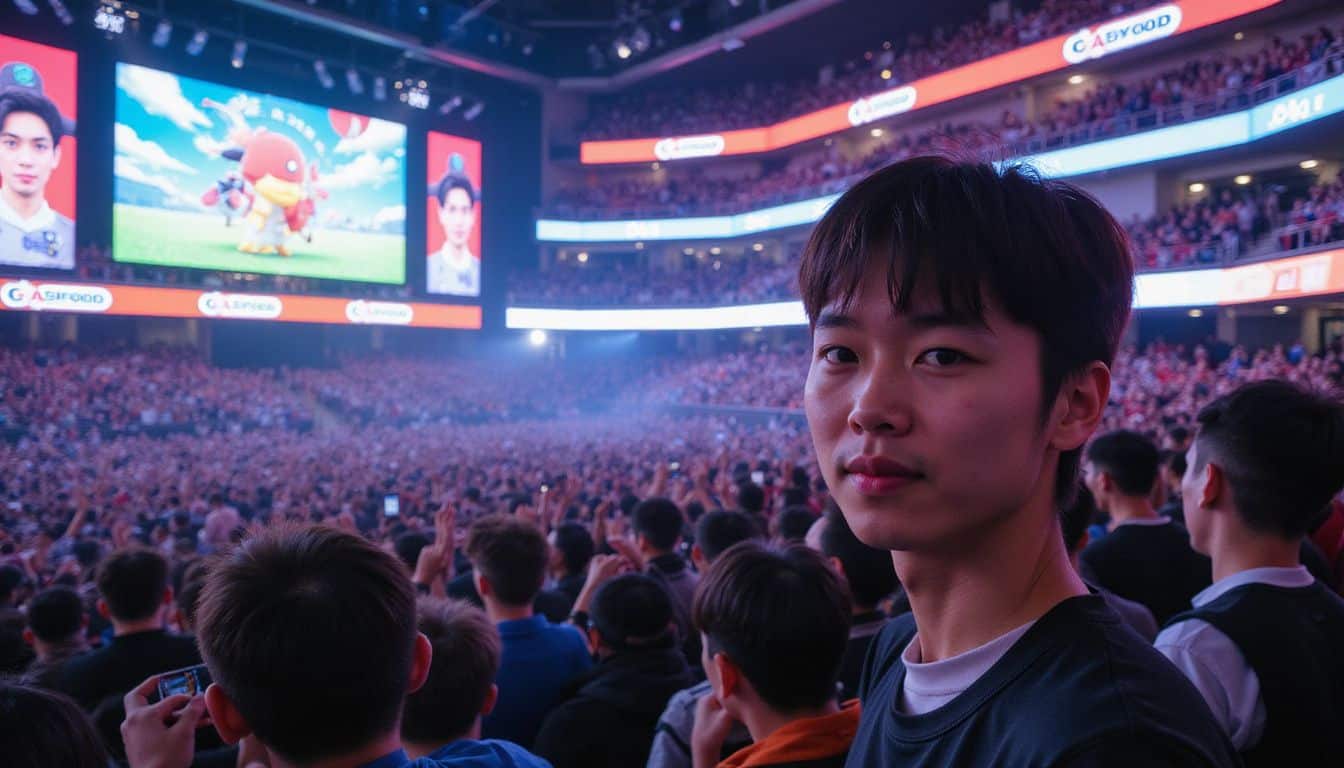
Japan’s esports scene is booming, with packed stadiums cheering pro gamers competing in hit titles like Pokémon and Street Fighter—curious to find out what’s behind this big buzz?
Competitive Gaming Culture
Competitive gaming has become big in Japan, boosted by the rise of esports. Thousands now flock to modern venues that host intense matches of popular titles like Pokémon and even classic games inspired by arcade hits like Space Invaders.
This shift from traditional arcades shows how strongly gamers prefer more social and competitive setups—including specialized gear such as gaming toilets for maximum comfort during long play sessions.
New arenas allow friends to cheer on teams competing in action-filled tournaments streamed live worldwide.
Popular Esports Titles
League of Legends remains big in Japan’s esports scene, especially with huge yearly events like the World Championships. I attended Worlds in Yokohama, and the energy from fans was intense as teams fought close matches.
Valorant continues to rise fast through franchised leagues and strong Twitch views that often beat long-time favorites. Mobile games have grown too, with titles like Bang Bang and PUBG Mobile gaining lots of attention among gamers who prefer phones over consoles or arcade games in Japan.
These newer mobile hits attract younger players who grew up after classic console gaming eras such as Famicom’s fourth-generation systems or NES-era Final Fantasy games became popular across homes nationwide.
Major Esports Events
Popular esports titles set the stage for major gaming events across Japan. These tournaments draw huge crowds, fuel competition, and shape gaming trends in Japan.
- EVO Japan 2025 is a top fighting game event set to take place in Tokyo. It will feature popular games from arcade machines and home consoles, including classic hits like Street Fighter and Tekken.
- Tokyo eSports Festa 2025 is another key highlight, mixing competitive play with tech showcases. Fans will enjoy matches from console gaming to mobile gaming arenas, as well as VR and AR demos.
- Japan PARA eSports Festival 2025 stands out by promoting inclusive gaming for players with disabilities. The festival will include events tailored to handheld consoles like Nintendo Switch and competitions featuring simulation RPGs such as Pokémon.
- BitSummit hosts competitive matches among indie developers competing for awards each year. Visitors get hands-on experience playing creative visual novels, gacha games, and action titles designed by local studios.
- Computer Entertainment Developers Conference (CEDEC) offers technical panels on trends shaping the Japanese video game industry in esports technology including blockchain integrations and AI-enhanced player analytics.
- GPU Technology Conference (GTC) Japan highlights hardware advances driving the next-gen esports scene through innovations such as powerful graphics cards enabling realistic virtual reality (VR) contests.
These events boost exposure for both seasoned game franchises like Final Fantasy and new releases developed specifically around live service models or subscription play styles favored today among gamers in Japan’s esports community.
Challenges Faced by the Japanese Gaming Industry

Gaming companies in Japan face tough battles from global hits like Western RPGs. The arcade scene, once famous for Space Invaders machines, keeps shrinking year after year.
Declining Arcade Gaming Scene
Arcade machines once ruled Japan, with titles like Space Invaders drawing huge lines at game centers. Yet by 2013, arcade revenue had fallen sharply to just 470 billion yen ($4.1 billion).
The boom in mobile gaming has dragged players away from cabinets and into the convenience of smartphones. Many arcade spots across Tokyo that I visited a few years back have closed their doors or turned into prize claw shops filled with Pokémon plushies instead.
New tech trends such as virtual reality (VR) and augmented reality (AR) challenge traditional arcades even more. Though VR games may revitalize old centers, they also highlight how out-of-date classic formats like pinball seem today next to headsets and motion sensors.
To keep pace with intense competition globally and locally, Japanese companies must adapt quickly—something easier said than done amid shifting player tastes worldwide.
Intense Domestic and Global Competition
Japan’s game industry faces tough battles both at home and abroad. Big local names like Nintendo, famous for the NES/Famicom and Pokémon, compete fiercely with global players such as Sony’s PlayStation and Microsoft Xbox.
Mobile gaming giants also heat up this contest, driving rapid shifts from console gaming to Android and iOS titles in recent years.
In 2022 alone, Japan’s content exports—including games like Final Fantasy—hit 4.7 trillion yen overseas. The recent “Cool Japan Strategy,” launched by the Japanese government aims even higher: a massive leap to 20 trillion yen of global sales by 2033.
To reach that goal amid stiff competition will require game makers to adopt international trends early while responding quickly to changes in platforms—even embracing virtual reality (VR) or augmented reality (AR)—and catering better to overseas gamers’ tastes than ever before.
Next we’ll take a look into how these companies are adapting their products specifically for success in international markets.
Adapting to International Markets
Adapting games for global success calls for more than translating text and menus. Over 60% of Japanese gamers prefer familiar genres and storylines, so developers must research carefully to grasp local tastes abroad.
Final Fantasy, Pokémon, and Color TV-Game gained huge appeal overseas by blending unique Japanese elements with broader cultural themes. To succeed globally, gaming companies like Nintendo focus on careful localization efforts — avoiding issues from the video game crash known as Atari Shock in 1983 — while protecting their content through strong intellectual property rights.
Strong anti-piracy measures keep popular titles safe and valuable worldwide.
Opportunities for Growth in the Japanese Gaming Industry

Japan’s gaming scene is ready for bold moves, with cloud gaming and new AR tech leading the charge. Partnering across cultures to merge unique ideas could open doors wide in Japan’s lively gaming market.
Expanding Mobile and Cloud Gaming
Mobile gaming continues to boom, accounting for nearly half of global gaming sales with around $92 billion in 2024 alone. Players are shifting away from console gaming like the Wii U and Family Computer / Nintendo Entertainment System toward smartphones packed with gacha games or classic JRPGs such as Final Fantasy and Pokémon.
Cloud services allow gamers to stream titles without costly consoles or handheld devices, offering low-cost options and ease of access.
To meet these mobile demands, developers must shift monetization strategies beyond simple pay-to-play models. Innovative cloud platforms create fresh streams of revenue while providing players instant playability directly from browsers or apps.
Companies stepping up their presence in mobile spaces can secure strong market positions by leveraging new ways for users to engage smoothly online without downloads or physical hardware limits.
Innovations in VR and AR Integration
VR and AR tech will shake up Japanese gaming big time by 2025. With Japan’s gaming market hitting $26.3 billion in 2024, advances in virtual reality (VR) are turning classic console games like Final Fantasy into fully immersive quests with realistic haptic feedback gear.
Augmented reality (AR), made popular globally through Pokémon Go, continues to evolve; smart glasses and advanced mobile apps now blend digital worlds smoothly with daily life. Cloud-based systems let gamers stream VR worlds without high-end consoles or PCs, lowering entry costs for eighth generation of video game consoles.
By combining AR visuals with real-world spaces and adding more social gameplay features, developers attract both casual players hooked on gacha games and hardcore JRPGs lovers alike—pushing Japan’s total gaming industry toward a massive $60.5 billion value by 2033 at a steady growth rate of 9.7% per year from 2025 onward.
Cross-Cultural Collaborations with International Developers
Cross-cultural teamwork can spark fresh ideas and creativity in game design. In the 1980s, Square hired Nasir Gebelli, an Iranian-American developer, who shaped classic JRPG hits like Final Fantasy with unique Western coding techniques.
Arsys Software from Japan created Robotrek in 1994, blending Japanese story-telling styles with gameplay popular in global markets. Successful gaming brands like Pokémon have grown stronger by merging cultural aspects that attract fans worldwide.
Smart developers carefully learn about their target audience’s culture to select relevant themes and elements for more engaging video games.
Events such as Tokyo Game Show (TGS) or BitSummit offer great chances for international creators to meet Japanese studios face-to-face. Meeting at conferences helps build genuine partnerships based on trust and clear communication between groups from different backgrounds.
These relationships enhance innovation through shared knowledge of tech trends such as virtual reality (VR), augmented reality (AR), cloud platforms, and mobile gaming features suited for diverse preferences around the globe.
The exciting scene of events within Japan’s vibrant community supports these meaningful connections every year.
Events and Conferences in the Japanese Gaming Scene

Japan hosts lively gaming events, where consoles like PlayStation and famous franchises such as Pokémon often take center stage—curious about what happens at these gatherings, read on!
Tokyo Game Show (TGS)
Tokyo Game Show 2025 (TGS2025) will occur from September 25 to September 28, 2025. It expects over 6 million visitors, making it Japan’s largest gaming event yet. The theme for TGS2025 is “Unlimited, Neverending Playground,” hinting at new and exciting ways to play beyond regular console gaming or mobile gaming trends in Japan.
Famous game series like Pokémon and Final Fantasy alongside innovations such as virtual reality (VR), augmented reality (AR), live service games, arcade classics similar to Space Invaders, and displays of haptic feedback devices will fill the show floor with fun.
There will also be showcases focused on esports tournaments featuring popular competitive titles and large events that celebrate Japanese Role-Playing Games (JRPGs). Visitors can test upcoming games first-hand through interactive demos across various platforms including handheld consoles, home consoles like past NES releases or Wii U systems, mobile gacha experiences, visual novels from known developers — all highlighting fresh ideas destined to shape future gaming styles.
BitSummit
While Tokyo Game Show (TGS) draws huge crowds for big-name games like Final Fantasy and Pokémon, BitSummit puts indie creators under the spotlight. BitSummit the 13th is set to run from July 18-20, 2025 at Miyako Messe in Kyoto, Japan.
Its theme is “Summer of Yokai,” mixing Japanese folklore with creative indie games. This event offers geeks hands-on play sessions with fresh mobile gaming titles, unique VR experiences, visual novels full of charm or gacha games that get you hooked fast.
Over 23,000 gamers attended BitSummit 2022—a solid show of love and support for Japan’s growing indie gaming scene.
Computer Entertainment Developers Conference (CEDEC)
After indie devs have their moment at BitSummit, CEDEC grabs the spotlight next. Japan’s largest conference for video game tech, CEDEC2025 will run from July 22 to July 24 at PACIFICO YOKOHAMA North.
With the theme “Innovating Fun,” industry pros explore new tools like Virtual Reality (VR), Augmented Reality (AR), mobile gaming trends, and breakthroughs in AI-powered games. Unlike Tokyo Game Show, which targets gamers directly with titles such as Pokémon or Final Fantasy demos, CEDEC draws those who build console gaming systems and cutting-edge software—shaping how we’ll play tomorrow.
GPU Technology Conference (GTC) Japan
GPU Technology Conference (GTC) Japan is set for March 17–21, 2025. This key event from NVIDIA covers the full range of GPU technology and shows geeks how graphics power shapes gaming in Japan.
From cutting-edge Virtual Reality (VR) to new Augmented Reality (AR) gameplay features, GTC Japan gives gamers a clear look at what’s next for titles like Pokémon and Final Fantasy.
Attendees explore innovations that push console gaming beyond limits once seen with NES’s early days or arcade classics such as Space Invaders and Speed Race.
How Foreign Companies Can Enter the Japanese Gaming Market

Getting into Japan’s gaming market means learning how gamers here connect with brands and developers. Success depends on adapting content, building local ties, and savvy use of platforms like mobile gaming and social media.
Understanding Consumer Behavior
Japanese gamers have high expectations and stay loyal to brands they love, like Pokémon, Final Fantasy, or iconic games such as Space Invaders. Younger groups—Millennials and Generation Z—are now the strongest force in Japan’s gaming market; these players favor mobile gaming over traditional consoles due to busy lifestyles and ease of use.
Older generations play more casual puzzle-type apps to keep engaged as Japan’s population continues aging fast with fewer births each year. Companies planning entry into this competitive market must pay close attention not just to game quality but also cultural details—from simple language localization down to subtle design touches inspired by things like Japanese style tattoos.
I once noticed how a poorly translated menu bothered hardcore Japanese RPG fans playing a classic remake on launch day; small details matter greatly here.
Localization and Cultural Adaptation
A deep grasp of consumer behavior makes adapting games for local culture simpler. Localization means much more than translating text—it involves adjusting storylines, graphics, and character design to suit Japanese gamers’ high expectations.
Squaresoft’s Final Fantasy series and Nintendo’s Pokémon show how detailed cultural tweaks attract strong fan loyalty in Japan.
Foreign companies must go beyond language changes alone—icons, menus, even humor need close attention. A solid example is fixing interfaces so gacha systems feel familiar to fans who grew up with arcade hits like Space Invaders or classic console platforms since NES was released.
Building a loyal player base depends on respecting gamer traditions such as game quality symbols like Nintendo’s Seal of Quality while staying true to modern gaming trends in Japan from mobile gaming habits to Virtual Reality (VR).
Building Strong Local Partnerships
Strong local partnerships help foreign gaming companies enter Japan smoothly. Working closely with Japanese studios can cut through tough language and legal rules, speeding up your entry into this market.
For example, Square Enix built strong ties overseas by partnering on “Final Fantasy” titles; similarly, global hits like “Pokémon” reached new heights through trusted cross-border deals.
In 2025, teaming up with experienced arcade game makers or mobile gaming firms in Tokyo will boost success rates.
Finding the right partner begins by attending key events like Tokyo Game Show (TGS) or BitSummit to network directly with insiders from Nintendo or Sega. I once saw firsthand how a small studio made big leaps just by aligning itself early with local leaders who knew player habits best and handled tricky localization needs easily.
Online marketing alone does not always work — gamers here trust familiar brands shared widely between friends on social apps more than flashy worldwide ad campaigns.
Leveraging Social Media and Marketing Strategies
Social commerce is growing fast in Japan, especially on Instagram and LINE. These platforms let gaming companies sell games straight to users, making buying easy through clicks and likes.
YouTube Live and Niconico Live are huge there too; streams of Pokémon or Final Fantasy battles draw lots of viewers every day. Smart brands use short, fun videos that work well on mobile screens.
As most gamers go online with phones, all marketing must load quickly and smoothly for a great mobile experience.
The Future of Gaming in Japan

AI will soon shape Japan’s game design, making characters smarter and stories deeper. Also, gamers might use more blockchain tech to own virtual items—changing how players trade and collect.
Haptic Feedback Devices and Immersive Technologies
Haptic feedback devices took gaming realism to a new level in 2023. These gadgets send physical cues, like vibrations or pressure, straight into your hands and body to match game action.
Popular Japanese games such as Pokémon and Final Fantasy have pushed these tech advances forward. Immersive technologies such as virtual reality (VR) and augmented reality (AR) also rose sharply this year due to top-selling titles that used them well—like bringing the thrill of arcade classics Space Invaders directly into your room through AR headsets or diving deep into fantasy worlds with VR rigs connected to home consoles.
With mobile gaming booming in Japan, expect haptic devices and immersive experiences for smartphones next.
Another big leap has been integrating these gadgets with handheld consoles—a core part of Japan’s gaming culture since the Famicon days. Nintendo Switch already offers HD rumble vibrations; imagine by 2025 feeling textures clearly when playing JRPGs on handheld systems during daily commutes around Tokyo metro stations! Brands focusing on gacha games plan similar innovations: making character pulls even more exciting through detailed touch sensations on screens paired perfectly alongside stunning visuals from immersive technology apps developed specifically for gamers who always want fresh thrills at their fingertips every session played—with eyes set firmly toward how artificial intelligence shapes future developments next!
The Role of AI in Game Development
Alongside immersive gadgets like VR and AR, artificial intelligence (AI) is changing gaming. Smart AI helps create better NPCs that act more like real players do in games such as Pokémon or Final Fantasy.
Developers also use machine learning to design game levels that match player skills and actions. Even old-school classics, from Space Invaders to seventh-generation console titles, could get exciting new versions with advanced AI.
In 2025, Japan’s game developers may depend on clever algorithms for tasks from graphics creation to testing gameplay balance—all speeding up production without losing quality.
Broader Adoption of Blockchain in Gaming
Blockchain gaming in Japan is booming and reached a market size of $826.9 million in 2024 alone. By 2033, this number should rise to an impressive $77,022.2 million. Web3 games let players own, trade, or sell their game items for real value.
Imagine trading unique Pokémon cards or rare Final Fantasy gear as digital assets you truly control on blockchain ledgers.
Mobile gaming platforms already see growing use of NFTs and crypto-based collectibles that players love to gather and exchange online. On top platforms like VR and AR systems—which blend virtual with real life—blockchain could let users track asset ownership simply and securely without risk of cheating or loss.
As Japan moves from console gaming into mobile trends, gamers will soon expect these shared economies across action games, JRPGs, gacha games—and even casual visual novels—to be the new normal by 2025.
How Will the Japanese Gaming Industry Evolve in 2025?

The Japanese gaming industry stays strong and ranks third largest in the world. Mobile gaming will keep growing fast, driven by daily commuting habits and ease of access. Popular genres like JRPGs (think Final Fantasy), action games, visual novels, and gacha games hold player interest deep into 2025.
Big hits such as Pokémon Go prove how augmented reality (AR) keeps gamers glued to their smartphones.
Console giants like Nintendo and Sony must adapt quickly due to falling market shares at home and tough global rivals. Long-loved series such as Dragon Quest still guide marketing methods today.
Gaming trends in Japan also include a rise in virtual reality (VR), cloud services, AI-driven game design, live service models favored by younger players—and even niche growth areas like poker in Japan.
From classics inspired by Space Invaders to Genyo Takeda’s impact on consoles since Wii U times—the future looks bright yet challenging for Japan’s industry leaders moving ahead into 2025.
People Also Ask
What gaming trends in Japan will shape play by 2025?
By 2025, mobile gaming and console gaming will keep growing strong, while virtual reality (VR) and augmented reality (AR) become more popular. Classic games like Space Invaders, Final Fantasy, and Pokémon will also influence new titles.
How did the history of video games in Japan affect today’s market?
Japan’s game industry faced challenges—like the Atari shock—but bounced back during the fourth generation with hits such as Final Fantasy. These events shaped how Japanese companies create successful games today.
Will classic franchises like Pokémon still matter to gamers in 2025?
Yes, beloved series like Pokémon continue to attract fans through fresh stories and gameplay features on both mobile gaming platforms and consoles—keeping them relevant well into 2025.
Is virtual reality (VR) or augmented reality (AR) becoming bigger for Japanese players?
Both VR and AR are gaining popularity among gamers in Japan because they offer exciting ways to experience favorite characters from classics such as Space Invaders or newer releases inspired by Wii U titles.
Do cookies have any role within Japan’s future gaming trends?
Cookies don’t directly impact gameplay itself; instead, they’re used behind-the-scenes online—to track player choices on mobile devices or consoles—and help developers improve user experiences across different types of games heading toward 2025.
References
https://carterjmrn.com/blog/the-evolution-of-gaming-culture-in-japan-from-arcades-to-mobile-gaming/
https://www.conduit.gg/blog/posts/the-evolution-of-the-japanese-game-industry-a-deep-dive
https://www.statista.com/topics/5589/console-gaming-in-japan/
https://aaagncy.com/wp-content/uploads/2025/03/Japans-World-of-Gaming-2025.pdf
https://superfaction.com/blog/japan-mobile-games-market-trends-to-succeed-in-2025/ (2024-10-10)
https://www.statista.com/forecasts/1410306/preferred-video-game-genre-in-japan
https://www.archivemarketresearch.com/reports/gacha-games-15946
https://www.researchgate.net/publication/355121908_What_is_a_Visual_Novel (2021-10-10)
https://allcorrectgames.com/insights/the-gaming-market-in-japan-2/ (2024-08-19)
https://www.imarcgroup.com/japan-virtual-reality-gaming-market
https://www.bonafideresearch.com/product/6407161805/japan-gaming-console-market
https://www.expertmarketresearch.com/reports/japan-gaming-console-market
https://metapress.com/the-most-popular-esports-game-in-2025-whats-dominating-the-competitive-scene/
https://www.ituaj.jp/wp-content/uploads/2022/07/nb34-3-1_Global_Rise_eSports_Japans_Prominence.pdf
https://info.jelper.co/post/game-and-anime-industry
https://www.blog.udonis.co/mobile-marketing/mobile-games/gaming-industry
https://www.statista.com/outlook/amo/ar-vr/japan
https://events.nikkeibp.co.jp/tgs/2025/en/exhibitor/ (2025-02-21)
https://cedec.cesa.or.jp/2025/en/
https://japan-dev.com/blog/best-tech-conference-in-japan?lang=jp
https://cdnw8.eu-japan.eu/sites/default/files/2021-01-japanese-consumers-behavior_0.pdf
https://scalingyourcompany.com/enter-the-japanese-gaming-industry/
https://www.kantanai.io/localization-trends-for-gaming-in-2025/
https://www.digitalmarketingforasia.com/10-digital-marketing-trends-in-japan-for-2025/
https://gam3s.gg/news/immutable-blockchain-gaming-asia/ (2025-03-12)
